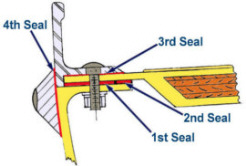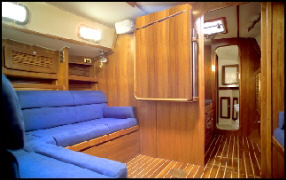Playing devil’s advocate, if Caliber wanted a more effective collision bulkhead, they’d reposition it farther aft-say, at the bulkhead between the salon and the forward stateroom, which would account for holes that could be punched in the sides, forward, by a container. Then, Amel-style, they should add a heavily gasketed door, for access forward, with positive locking and sealing device. But, again, any collision bulkhead is a lot better than no such device, and Caliber is one-up on many builders for its presence on their boats.
Similarly, Caliber’s waterline-high "rudder-post dam" is designed to contain seawater in the event of damage to, or failure of, the rudder stuffing box. This is a clever idea that makes a lot of sense so long as the leak can be flagged early and the repair made quickly. Toward this end, rigging a bulge pump inside the dam to an alarm or light will give early notice of a leak at the rudder-post bushing.
 The four-way deck-bonding system, an example of a belt and suspender
system which makes the Caliber 40LRC so rugged.
The four-way deck-bonding system, an example of a belt and suspender
system which makes the Caliber 40LRC so rugged.
 Handholds abound in the open
saloon layout. The joinery is well executed.
Handholds abound in the open
saloon layout. The joinery is well executed.
Average ratings for hull
construction and hull-deck joint are a relatively lofty 8.7, again due
in part to 40LRC owners’ knowledge and appreciation of the "Quad-Seal
Deck to Hull System" hull-deck joint. Caliber takes four steps to join
and seal the deck to the hull--3M 5200 in the hull-deck flange;
co-polymer tape around the inside perimeter of the flange; 5200 under
the slotted aluminum toerail, which is also thru-bolted; 5200 between
hull-deck seam and rubrail, which protects the hull-deck joint. An
average score just under 9 for "dry below decks" bears out the success
of this joint. Deck construction-fiberglass over marine plywood, which
doesn’t fail under compression-received a high score of 8.9.
Chainplates also received
an average score of just under 9. Survey respondents thought highly of
Caliber’s "Double-Lock Chainplate System" that first locks the plate to
the horizontal surface of the hull, then clamps it to an oversized
bulkhead "thoroughly bonded" to the hull. This also further strengthens
the hull-deck joint by reducing flexion between the deck and cabin
molding and the hull.
The keel-hull joint
received a 9.3, because the modified fin is integral to the hull with no
external keel bolts, and its weight and the forces that come to bear on
it are distributed over the grid structure. Internal or encapsulated
ballast has its pros and cons. A serious grounding can permit the
ingress of water to the hull laminate while an exposed lead keel will
absorb the shock with no more than a dent incurred. That said, an
exposed keel relies on keel bolts and a keel-hull joint that will, in
the end, be a source of leaks. We can comfortably agree with Caliber and
others that an encapsulated keel is a prudent and